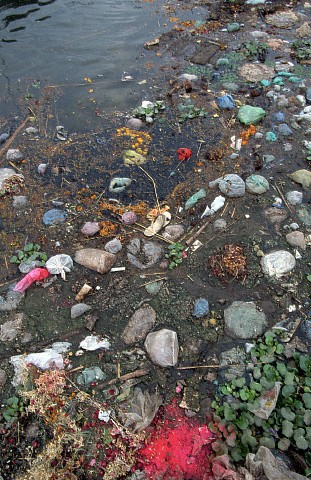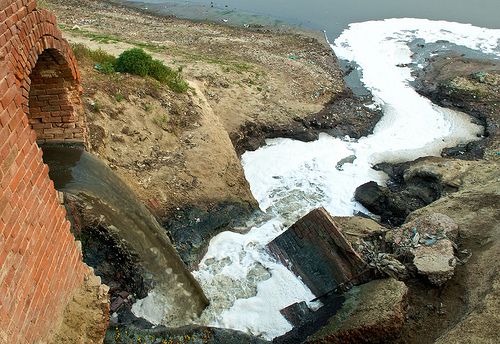Course:ECON371/UBCO2009WT1/GROUP3/Article4
Article 4: India plans £2bn clean-up of the Ganges
India plans £2bn clean-up of the Ganges
Summary
The Ganges River has great religious significance for a majority of Indians and is considered “one of the country's greatest attractions”(Telegraph). The article looks at a reknewed effort at cleaning up the river which is being polluted with “billions of litres of excrement, chemical waste, ashes and the bloated bodies of dead humans and animals”(Telegraph).
From a cultural standpoint, efforts to clean up the river center around the achievement of a “bathing standard” as it is common practice for Hindus to wash in Ganges as part of their spiritual excercise. The high pollution in the river might harm those who bathe in it—resulting in health care costs and lost production—and might in fact stop some Hindus from bathing in it entirely, reducing their utility of religious expression. Emissions also damage the Ganges potential as a tourist attraction which has an impact on India's tourism revenue.
The article lists two competing ideas of how to clean up the Ganges:
- 1. The government plans to take out a loan of 1.5 billions pounds from the World Bank in order to increase the number of water treatment plants to reduce emissions into the Ganges which would “bring sewage levles down towards bathing standard by 2020(Telegraph).
- 2. A member of the Centre for Environment and Science(CES) believes that the government plan does not properly take into account the cost of maintaining the plants and the cost of delivering sewage to these plants. He proposes limiting the amount of drinking water which is diverted into the cities from the Ganges, so that fresh water can flow into the river such that a safe ambient level of pollution can be attained.
Analysis
Emission Control versus Ambient Concentration Control
The government's approach to clean up the Ganges would follow the 5-3 c) diagram in the textbook. They would make an initial investment that would allow them the infrastructure to reduce emissions into the Ganges. Their strategy is essentially to supply the abatement costs necessary to achieve the bathing standard. The money used to pay the loan and continued costs of abatement might come in the form of tax revenue or funds diverted from other projects.
Pros
-less emissions in the river improves utility of the Ganges
-creates jobs
Cons
-1.5 billion dollar loan increases India's debt
-higher taxes and sacrifices in other programs
-does not address the problem of sewage or other pollutants that go directly into the river
The CES representative's solution is to increase the fresh water flow into the Ganges thereby reducing the ambient concentration of sewage for a particular level of emissions. That is, the MD curve, on a cost vs emissions graph, will flatten more, moving the efficient level to the right on the graph. The 'bathing standard' moves to the right. CES believes they can move the bathing standard over far enough so that existing infrastructure will be sufficient to deal with the sewage. The cost of this program comes in terms of the amount of fresh water available to the citizens of the cities who now enjoy fresh water from the Ganges.
Pros
-doesn't require any additional investment in capital
-achieves ambient standards necessary for safe bathing
Cons
-cities lose a source of drinking water
-from a moral standpoint it seems not to address the emission problem
Other Possible Soutions
- 1. Create a law so that defeciation is now illegal. This would be very difficult to enforce as the area of the river is so large, and also very rural and it would be near impossible to constantly monitor the activity of civilians. Perhaps random checks could be a possible soultion. Enforcement would most likely to be costly, and if people are desperate enough they will not be too concerned over the fine. An appropriate fine would have to be placed, but most people defectiacting into the Ganges are fairly poor so they may not even have the appropriate resources to pay their fine off!
- 2. Invest money into the maintenance of the toilets located in towns. People would rather use the river as an excretement source than a publically provided toilet as the toilets are often very dirty and are overflowing. The government needs to decide if the cost of maintaining the toilets is worth the benefits of people using the toilets instead of the Ganges River.
Conclusion
It would be difficult to choose one solution over the other as both have their pitfalls. The government solution seems like “throwing money at the problem” rather than finding long term solutions. If technology should improve considerably in the next while, all the money spent now, might be wasted. The CES solution seems somewhat like "trying to hide the problem". What happens if emissions increase and there is no more fresh water to dillute the pollution? How do you replace the fresh water currently being used by the city? One idea might be to partially implement the CES plan to begin with and use the funds that would have otherwise gone to the government plan to improve infrastructure(toilets and so on) and to find alternate means of drinking water(desalinization plants). The cities that divert water from the Ganges could be charged a fee(or a greater fee) for its use, the funds raised being invested in treatment plants and programs. This might improve the efficiency of the water's use and lead to less fresh water consumption which could lead to more fresh water being allowed to flow into the Ganges. Overall, it's a difficult decision for a developing country with such a large population and the added religious significance of the river makes this an environmental problem unique to India.
Prof's Comments
Nice description of how increasing fresh water is akin to rotating down the MD curve. Investing in more public toilets is probably a good solution, as it does relate to the behavioral issue - people just have to go, and will go somewhere. However, those toilets need to connect to some sort of a sewage treatment system, and that is where a large part of the problem seems to be.

